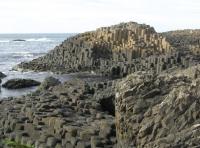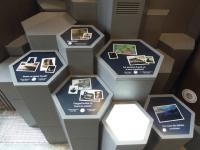Big questions at the Giant’s Causeway
Published in Issue 6 (Nov/Dec 2012), Platform, Volume 20
The Giant’s Causeway, Co. Antrim—over 700,000 visitors per year.
The recent controversy surrounding the inclusion of a creationist perspective at the National Trust’s new £18.5 million Giant’s Causeway interpretive centre has prompted much public discussion in Northern Ireland and further afield. To date, the debate has been one of ‘science versus creationism’ and of whether and to what extent the Trust—or, indeed, any museum—should ever include a creationist perspective. While these are urgent issues, the arguments put forward by both sides have been predictable in both their content and their tone. This is a necessary debate but not a new one.
The episode raises another fundamentally important and challenging question for those of us interested in history and involved in its exhibition: what is the purpose of interpretation in the first place? And, in that context, how has the exhibition at the Giant’s Causeway succeeded or failed? This goes beyond the issue of creationism: we must ask the bigger question of what we are trying to achieve within interpretive spaces at all. This is a perennial issue but its brief discussion here is timely. These pages have recently examined the 21st-century retelling of the Titanic story and have also suggested how the Irish Revolution could be narrated. Elsewhere we have been considering the ways in which the upcoming centenaries might best be commemorated and interpreted (noting the distinction).
What is interpretation?
Interpretation is a relatively new concept in this context. Over the past 40 years or so museums have, in response to political and economic pressures, slowly undergone a paradigm shift in their relationship with the rest of the world. The linear ‘transmission’ model, in which the museum lectured to a passive public, has gradually been replaced by a more reflexive, ‘transactional’ one. Individuals are invited to become active participants in the making of their own meaning, engaging with the museum and its staff, learning from each other and contributing their own perspectives—and, increasingly, their own objects—to the museum. This shift is also reflected semantically: ‘the public’ is now variously identified as audiences, communities, visitors, customers and stakeholders. To remain relevant, the museum (and any other body responsible for interpretation) must now not only appeal to its communities/visitors/stakeholders but also consult and work with them.
The new museology
The ‘new museology’, as this approach has become known, raises many philosophical issues about the nature of knowledge and truth, and where they reside. Most of all, it challenges us to consider the ways in which we make meaning in museums. What, for example, are the roles and responsibilities of the institution and what are those of its audiences? Who determines the meaning of an object—the person writing the exhibit label or the person reading it? Where is the line between interpretation and instruction? And, critically, how does the museum retain its authority?
Such discussions can quickly become knotty but they are a reminder that all history is interpretation and that interpretation itself is mediated through people. Behind every exhibition, every exhibit, is a series of decisions, made by everyone from funders to label-writers. They must decide what and whom to remember; with whom to consult, and in what proportion; which objects and words to use in telling a story; and whose narratives to include. Consciously or not, many things are also forgotten. As Ludmilla Jordanova has written, museums are full of ‘significant silences’.
These are big ideas, presented only in broad strokes here, but they are some of the most critical questions that challenge museums and interpretive centres in their everyday work. Many of these issues are thrown into sharp relief by the recent series of events at the Giant’s Causeway.
Interpretation at the Giant’s Causeway
In planning the interpretation for its new Causeway centre, the National Trust consulted with a number of stakeholders and other interest groups, including, as has been much publicised, an evangelical Christian lobby, the Caleb Foundation. As a result of the Trust’s engagement with the Foundation, a creationist perspective was included in the exhibition. In an audio track originally titled ‘The debate continues today’ (though amended within days of opening to ‘For some the debate continues’), this exhibit—until 3 October 2012—explained that:
‘This debate continues today for some people, who have an understanding of the formation of the earth which is different from that of current mainstream science. Young Earth Creationists believe that the earth was created some 6,000 years ago. This is based on a specific interpretation of the Bible and in particular the account of creation in the book of Genesis. Some people around the world, and specifically here in Northern Ireland, share this perspective. Young Earth Creationists continue to debate questions about the age of the earth. As we have seen from the past, and understand today, perhaps the Giant’s Causeway will continue to prompt awe and wonder, and arouse debate and challenging questions for as long as visitors come to see it.’
This text, and the process through which it was arrived at, highlighted many of the vulnerabilities and inherent tensions of the new museology and the transactional approach. In engaging with stakeholders the Trust was targeted by a highly motivated and effective lobby. In seeking to include multiple perspectives it elicited a point of view completely at odds with its own stance and with the rest of its interpretation. Through consultation with some constituents it managed to alienate others, who were surprised by the ‘specific’ connection made by the exhibit between Young Earth Creationism and Northern Ireland (particularly as the centre had received £9.25 million in taxpayers’ money). The exhibit’s implicit invitation to people to bring their own meanings to the debate about the earth’s formation highlighted a fundamental point of tension: while individuals can bring their own experiences to bear on their understanding of a scientific fact, the fact itself is not open to interpretation.

‘An ancient Earth or a new creation?’—the audio exhibit (since amended) at the heart of the controversy at the interpretive centre, which explores the historic scientific discussions about the formation of the Causeway.
The reaction
Visitors and other commentators responded vehemently in agreement and disagreement in the centre’s visitor book and, more publicly, in the press and on numerous on-line forums, including the National Trust’s blog. In reply, the Trust was at pains to point out that its intention was to give visitors a flavour of a range of historical perspectives rather than to promote or legitimise an unscientific view. On 18 July it announced that, to prevent any further misunderstanding of its position, it would review the exhibit and produce a report by mid-August. This willingness to engage with the public debate was greeted positively. In the language of the new museology, the Trust was responding to and addressing the concerns of its stakeholders—a crucial and encouraging step—and thereby extending the process of interpretation beyond its exhibition. In this context, the nine-week-long silence until the Trust completed its review and amended the text was unfortunate. In the meantime, the public debate only intensified—most vocally on the National Trust blog—without the input of the Trust itself.
While the Trust’s interpretive approach arguably made it vulnerable to this state of affairs arising in the first place, it also provided a framework within which it could be resolved. Within the transactional museum paradigm, we allow that museums and interpretive centres are fallible but expect them to address their mistakes publicly. The Trust’s failing in this case was not in its initial error of judgement but in the way it went about addressing its mistake. While the revised text is a big improvement and the act of public revision is to be commended, the process that effected this change failed to recognise a number of opportunities.
How might this incident inform how we think about interpretation more generally? Putting aside the specifics of the Giant’s Causeway exhibition, the institution and its stakeholders, the episode highlights some of the fundamental tensions of the transactional approach. These are issues that confront museums time and time again. The process of museum/stakeholder consultation is not only desirable but also essential. Museums should allow their audiences to speak up, to contribute their meaning and to have input into exhibitions. But how should the museum approach its stakeholders, or they the museum? What happens when stakeholders have an understanding that is at odds with that of the institution, or with that of other stakeholders? How can the museum balance the perspectives and narratives of its communities with its own authority?
These are difficult questions with no easy answers, but I believe that they are issues that deserve our attention. Those of us involved in the interpretation of heritage would welcome the scrutiny of our methods and processes in the hope that this might lead to these being better understood by all—ourselves included. HI
Sarah Shiel is an interpretive planner.
The full, revised transcript for the exhibit can be read at http://ntpressoffice.wordpress.com/2012/10/03/review-completed-at-giants-causeway-visitor-centre/.
















